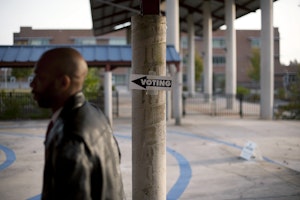Congress Has a Chance to Restore—and Strengthen—the Voting Rights Act
By Julie Fernandes

On June 25, 2013, the U.S. Supreme Court, in a 5–4 decision, struck down the key enforcement provision of the Voting Rights Act, known as section 5—a major blow to the half-century-old legislation. Section 5 ensures that electoral districts covered by the Voting Rights Act can’t make voting changes until it is determined that those changes will not have discriminatory purpose or effect. While acknowledging that racial discrimination in voting still exists, the chief justice wrote that, in his view, racial discrimination in voting is no longer a significant or widespread problem.
This is, of course, false.
We’ve seen plenty of evidence that racial discrimination in voting is alive and well, a fact that Justice Ruth Bader Ginsburg emphasized in her dissent when she noted that section 5 has been an effective tool to prevent discriminatory harms, and that invalidating it was like “throwing away your umbrella in a rainstorm because you are not getting wet.”
Indeed, evidence of section 5’s importance began to crop up in the immediate wake of this court’s decision, when Texas’s attorney general announced that a racially discriminatory ID law—which had previously been held by a federal court to violate section 5—would now be “in effect.” Forty-eight hours later, the speaker of the North Carolina House announced that he would move forward with a broad “election reform” bill that included provisions designed to have a negative impact on African American and Latino voters.
Advocates swung into action to challenge these laws. To support that effort, the Open Society Foundations worked with other funders to create the Shelby Response Fund to provide a pool of funds and a platform for grantees to coordinate a new litigation push. These grantees included the NAACP Legal Defense Fund, the Mexican American Legal Defense Fund, the Southern Coalition for Social Justice, the Lawyers’ Committee for Civil Rights Under Law, the Advancement Project, and many others. The result has been some major victories, including recent holdings by federal appellate courts that the Texas ID law and the North Carolina “election reform” bill were racially discriminatory.
While litigation has been effective in some cases, too often the remedies come only after the discriminatory laws have been in effect for years. And without the public-notice provisions that were part of the old section 5 system, many local discriminatory laws go undetected and undeterred. The only real solution to the continuing problem of racial discrimination in voting is for Congress to act to restore and strengthen the Voting Rights Act.
There are currently two bills pending in Congress that would do just that. Both bills create a new section 5 that focuses on places with a recent record of voting discrimination, and require those places to get federal preapproval before implementing any new voting law. They also require all states and counties to provide public notice of certain voting changes, and authorize the attorney general to send federal officials to observe elections anywhere where she believes there is a risk of racial intimidation at the polls.
So far, neither bill has been considered for an up or down vote in either the House or the Senate. Until that happens, racial discrimination at the polls remains not just plausible, but likely.
Until July 2018, Julie Fernandes was the advocacy director for voting rights and democracy at the Open Society Foundations.


